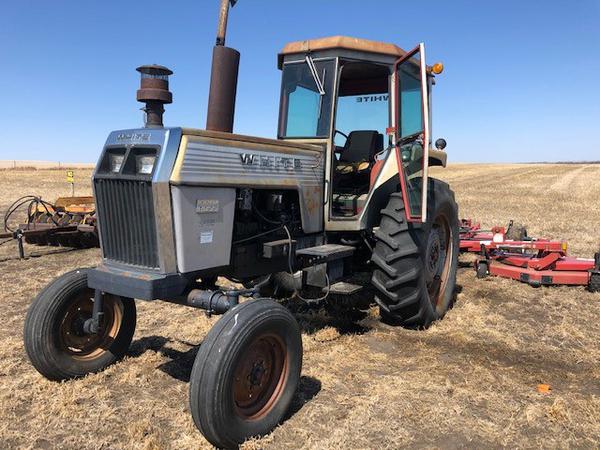Register an account with RME to store your favorite equipment and easily compare between units.
RegisterThe combine harvester is the most modern harvester of wheat. It’s called a combine because it “combines” the job of the header and thresher which were its predecessors. The combine is tied to the Midwest; it also had a great impact on the Northwest and specifically Washington State. The first combine was made by Hiram Moore in 1836 and was ahead of its time (Keith). Change wasn’t accepted so it would have to wait till the end of the century for its turn. After it did become the dominant harvesting method, it revolutionized the way the world ran. It was successful because it made farming safer, more profitable, and brought food to many. But through the1800s, the header and the thresher were king.
The header was pushed through the field by six horses from the back of the machine (Keith). Pushing from the back reduced crop trampling. On the front edge of the header was a row of sharp teeth called sickles (Brumfield). Sliding back and forth in a blur, they touched the wheat stalk first and sliced it. To keep the wheat from falling on the ground, a reel circled around and paddles knocked the wheat into the header (Doty). The height of the header could be changed to keep it out of the dirt, and to make sure all the wheat was cut. Then a draper in the bottom of the header slid to the side of the header like the belt on the checkout counter of a grocery store. The wheat went up a sort of chute, and fell down into a wagon driving alongside the header. This wagon was pulled by four horses (Doty). When the wagon was full, the header stopped, the wagon pulled out, another came in, and they started over. All moving parts were turned by the “bull wheel” which was like a gear. The header was 12 feet wide and could cut 30 acres a day (Brumfield).
Wagons then traveled to the thresher which was placed at a central harvest site to reduce distance traveled. The thresher was first run by horses walking in circles. Later, steam engines ran the machine (Keith). The wagon was unloaded and wheat was dropped next to the thresher. Here it was pitched inside the thresher (Schillinger). The thresher threshed the wheat until the kernels fell from the head. The kernels, having now been threshed, came back out of the machine in one spot, the straw and chaff came out another (Wiley). The thresher had a crew of six people. The “Separator man” was a talented mechanic who constantly serviced the machine. The “Sack-jig” filled the burlap sacks with grain that came out a spout (Brumfield/Ag Mag.). When the sack was full he passed it to one of two “Sack sewers” who sewed the sacks up lightning fast (Sherman). It is estimated that together, they sewed 1000 sacks a day. While the sacks weighed about 140 pounds, sewers tossed sacks 50 feet into a pile like they were weightless (Schillinger/Brumfield/Sherman). Since the thresher didn’t move, the straw that came out the back would eventually plug the machine. The “Straw-buck” threw the straw into a small wagon and hauled it away with a team of two horses (Ag Mag/Brumfield). Later, a fan blower was added that pushed the straw out and away from the machine. Then the “Straw-buck” didn’t have quite as much work. The “Fireman” burned wood to run the boilers. George Stockton Berry came up with the idea of burning straw to heat the boilers which produced the steam. Fires were occasionally started this way. The total harvest crew was about 30 men and 30 horses.
The Combine Harvester
In the early 1900s it was the combine’s time. The combine used the same number of people; however it did take up to 40 horses. Thirty to 36 pulled the machine; the rest pulled a wagon that gathered the grain sacks the sack sewers would throw off the machine as they rode along. Imagine that the thresher was the wagon that drove along the side of the header. Now attach the header to the side of the thresher and add about 30 horses to the thresher. This was the first horse drawn combine (Keith/Doty/Brumfield/Schillinger). Combines could weigh over fifteen tons and the header could be thirty feet wide. (See appendix 1) The combine could harvest 40 acres a day (Brumfield/Keith). The crew included the separator man, the driver, and the header tender who controlled the header, the sack jig, and two sack sewers. Despite everyone’s hard work, harvest crewmen earned only three dollars a day during the early 1900s (Green).
Now that you can compare the combine and thresher, it is plain to see why the combine is considered an innovation. Total harvest crews were now under 10 instead of over 30. This was huge for farmers since most had a tight budget. Besides a lunch break the combine could go all day without stopping. The thresher had to wait for wagons to come back so they didn’t dump the wheat on the ground. This saved hours of precious time. The combine could travel faster than a header because the horses pulled instead of pushed (Keith). They walked in front of the thresher portion, the wheat was to the side of them (Doty). The combine could harvest 40 acres a day instead of a couple hundred a season that the thresher could produce (Schillinger). Through 1911-1919, steam was slowly replaced with a gasoline engine which meant farmers didn’t need wood or straw to heat the boilers. The combine for some farmers meant bigger crops because they could get all their wheat cut before the rain without going bankrupt hiring men and machinery (Brumfield/Wiley). Like almost everything else, the combine wasn’t perfect. Before, it might have been easy to get a job on a threshing crew. With the numbers reduced from 30 or more to five or six, there were some people who might have been out of a job. It is possible that since the demand for machinery grew and the demand for machine shop workers grew with it, people might have found a job here instead.
Interested in owning a little bit of history yourself? Check out some of our latest machines.
Contact your local RME Branch for more info
RME has a great selection of new and used equipment to fit your needs. Visit RME DealZone
Share This Article:





